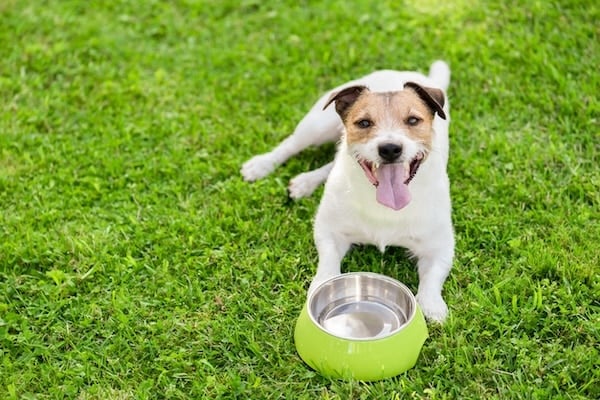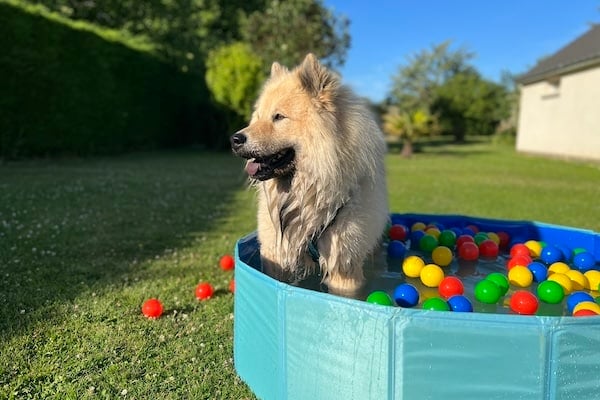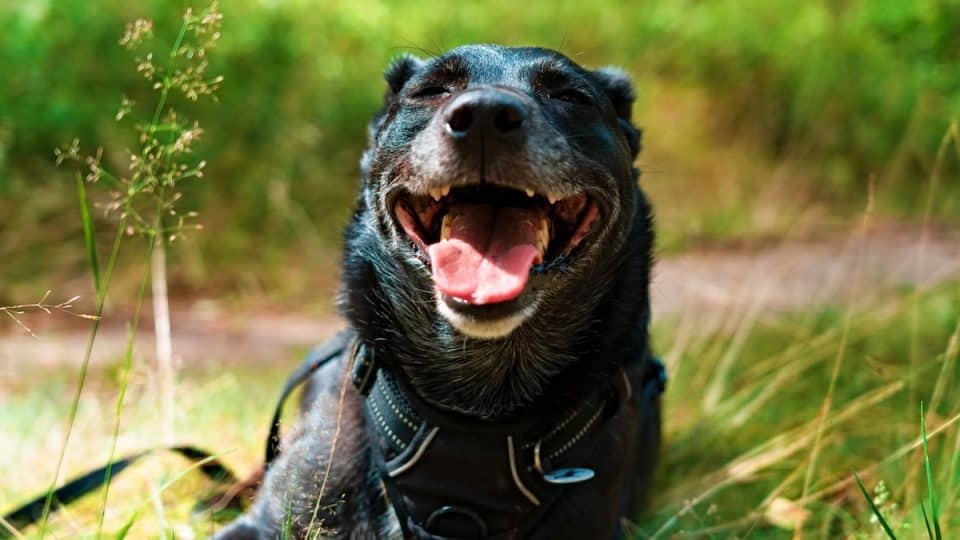- Not a substitute for professional veterinary help.
For lots of people and their pups, summer means time spent outside. But rising temperatures can be a lot for a dog, and they come with some real risks. Heatstroke is one of the biggest dangers. When a dog’s body temperature rises above 106 degrees Fahrenheit, dehydration, organ damage, and even organ failure can result.
Heatstroke can sneak up on you—things get too hot fast. “Exposure to high temperatures for even five minutes may be too long,” cautions Dr. Kathleen Mottel, DVM, with Glen Ellyn Animal Hospital. “Avoiding long periods of exposure to the sun without a fan, access to water, or the ability to take a break can be a health hazard.”
The good news is that heatstroke is preventable as long as you’re proactive. Here’s what you can do to help your dog cool down and stay cool during the season’s hottest days.
Quick Ways To Help a Dog Cool Down
When the weather gets hot, you might see your dog panting, hunting for a cool spot like a bathtub or linoleum, or hanging out by a water source. Here’s what you can do to help them cool down fast.
- Offer water with ice cubes in it or on the side for a cool snack, or try a frozen toy.
- Get out a dog-safe kiddie pool and let your dog splash or laze.
- Soak a dog bandana or a cooling vest in water and put it on your dog.
- Set up a cool, quiet spot with AC or a fan where your dog can rest. Consider adding a cooling mat for comfort.
- Give your dog a good brushing in the shade to remove extra hair that traps heat.
When to contact your vet
If your dog is so hot that they’re showing signs of lethargy, dehydration, discolored gums, or difficulty breathing, don’t wait—head straight to an emergency vet.
Try to cool your dog down quickly en route by offering room-temperature water and gently wetting your dog with cool water. A fan or air conditioning can help, but don’t shock their system with ice or freezing water. The goal is to keep your dog from getting any hotter until veterinary professionals can intervene.
How To Keep Your Dog Cool Without AC
Escaping to an air-conditioned house might be one of the easiest ways to keep your dog cool, but it’s not always possible. Here’s what to do if there’s no AC in your immediate future.
1. Increase hydration
Access to fresh water is critical to a dog’s health and comfort in the heat. On average, dogs should drink around an ounce of water for every pound of body weight per day—and likely more in hot weather.
Keep your pup’s water bowl filled, and consider bringing a portable water bottle and travel bowl on long walks. It can be helpful to offer your dog water every 15 to 20 minutes while walking during the summer.
If you suspect that your dog is becoming dehydrated, offer them little sips of water so that they don’t drink too fast and vomit. If they aren’t interested in water, try feeding them ice cubes. If your dog continues to refuse liquids, reach out to your vet, who can make sure your pup is healthy and help hydrate them intravenously in an emergency.

alexei_tm via iStock
2. Offer frozen treats and ice cubes
Letting your dog chomp on ice is a simple way to bring down their body temperature. There are also plenty of recipes for quick and easy frozen dog treats, which can appeal to a pup who doesn’t find ice tempting.
While frozen treats made with peanut butter, berries, and other dog-friendly foods can be cooling, they aren’t inherently hydrating—so you’ll also want to ensure a water bowl is available.
3. Avoid enclosed spaces
“During the hottest months of the year, proper airflow is one of the most important safety measures for humans and animals alike,” says Dr. Mottel. If you’re confining your dog to a certain room or part of the house, make sure it’s cool and comfortable.
Avoid letting your pup wait in the car alone even if windows are cracked. When the air conditioning isn’t running, this can be extremely dangerous on a hot and muggy day.
4. Try fans and cooling mats
Dog cooling products have come a long way in recent years. Dog cooling mats, made with either gel or ice, can offer an alternative to constantly seeking the coolest part of the linoleum. Our testers liked the Green Pet Shop model.
Crate fans can also make a difference in a dog’s comfort, though it’s still important to keep a close eye on the ambient temperature anywhere your dog is crated.
Tips for Outdoor Activities or Lounging
Enjoying the sunshine with your dog is one of the perks of pet parenthood. From cooling vests to puppy pools, these are some of the best ways to protect your pet from the heat.
Choose the right time to be outside
Planning out your walks is a good way to prevent heat-related health risks. Keep a close eye on the temperature, and avoid walking your dog in the middle of the day when the sun is usually at its peak. Vigorous activities—running or letting your dog get their zoomies out at the park—are safest in the morning or evening during summer.
According to Dr. Mottel, those living in climates with extreme heat should be careful when spending time outside for even a few minutes during the hottest parts of the day.
Stick to the shade when possible
Though your pup may enjoy basking in the sun, balance is key! Make sure to intersperse outdoor play (and lounging) with time in the shade. Darker fur absorbs heat more quickly, so dogs with dark fur are at a higher risk of overheating. Find a spot underneath an awning or tree and take water breaks often.
Pro Tip: Pavement can get very hot to the touch on sunny days. Reduce the risk of paw burns by checking the temperature, testing the ground with your hand, and avoiding asphalt.
Use dog cooling gear
If you’re planning on spending time outside in the summer, it can be worth investing in some gear.
Cooling vests are useful for sunny adventures, especially since most are easy to keep damp with a water bottle (or a swim). If your dog isn’t likely to tolerate anything as cumbersome as a vest, consider a cooling bandana.
Elevated cots are significantly cooler (and more weatherproof) than traditional dog beds, and they promote airflow. Some even come with a canopy for shade.
Finally, we’re big fans of dog-safe kiddie pools and sprinklers, which do everything from getting a skittish dog used to water to helping a toasty pup cool down. In the cooler months, they make good dog sandboxes and ball pits.

kipgodi via iStock
Cooling Down a Dog Myths
There are plenty of practical ways to beat the heat… and a few not-so-helpful ways too. Familiarize yourself with the below myths to avoid ineffective cooling methods.
Shaving a dog’s coat helps them cool down
While brushing or trimming your dog’s coat can be helpful in the summertime, shaving their coat disrupts the natural ability to cool down. In fact, a shaved coat can increase your dog’s risk of sunburn and overheating.
Fans are the most effective cooling tool for a dog
Though people lower their body temperature through sweat, dogs mostly cool down by panting—which means fans aren’t always that effective.
Crate fans can help because they create airflow and keep the crate from becoming a hotbox, but on a scorching hot day, your best bet is cooling bandanas, water, and air conditioning.
Cold water will shock dogs
For the most part, offering ice-cold water to help your hot dog cool down is effective. The myth that cold water will shock a hot dog hasn’t been proven. And while you don’t want your dog to drink too much too quickly, cold water can help regulate their body temperature.
The exception is a dog who’s actively experiencing heatstroke—ice water can cause these pups to shiver, which may increase their body temperature. If you suspect your dog has heatstroke, keep to merely cool water (no ice) and take your dog to the emergency vet ASAP.



